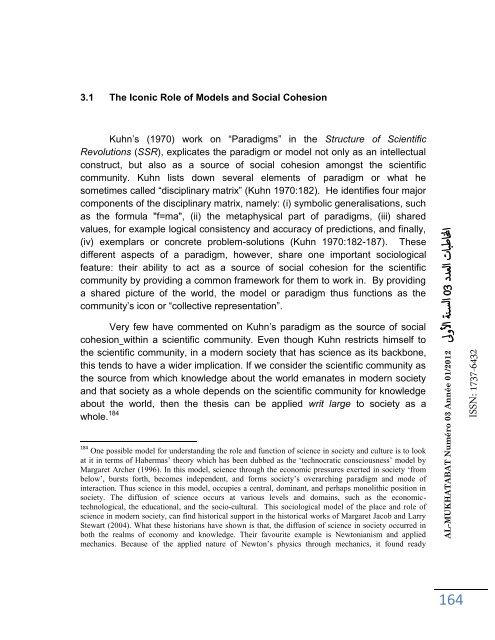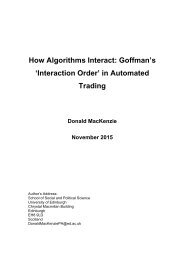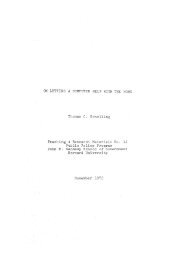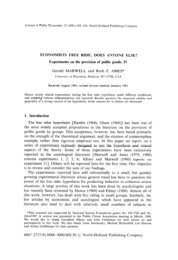n3-al-mukhatabat-journal
n3-al-mukhatabat-journal
n3-al-mukhatabat-journal
You also want an ePaper? Increase the reach of your titles
YUMPU automatically turns print PDFs into web optimized ePapers that Google loves.
3.1 The Iconic Role of Models and Soci<strong>al</strong> Cohesion<br />
Kuhn’s (1970) work on “Paradigms” in the Structure of Scientific<br />
Revolutions (SSR), explicates the paradigm or model not only as an intellectu<strong>al</strong><br />
construct, but <strong>al</strong>so as a source of soci<strong>al</strong> cohesion amongst the scientific<br />
community. Kuhn lists down sever<strong>al</strong> elements of paradigm or what he<br />
sometimes c<strong>al</strong>led “disciplinary matrix” (Kuhn 1970:182). He identifies four major<br />
components of the disciplinary matrix, namely: (i) symbolic gener<strong>al</strong>isations, such<br />
as the formula "f=ma", (ii) the metaphysic<strong>al</strong> part of paradigms, (iii) shared<br />
v<strong>al</strong>ues, for example logic<strong>al</strong> consistency and accuracy of predictions, and fin<strong>al</strong>ly,<br />
(iv) exemplars or concrete problem-solutions (Kuhn 1970:182-187). These<br />
different aspects of a paradigm, however, share one important sociologic<strong>al</strong><br />
feature: their ability to act as a source of soci<strong>al</strong> cohesion for the scientific<br />
community by providing a common framework for them to work in. By providing<br />
a shared picture of the world, the model or paradigm thus functions as the<br />
community’s icon or “collective representation”.<br />
Very few have commented on Kuhn’s paradigm as the source of soci<strong>al</strong><br />
cohesion within a scientific community. Even though Kuhn restricts himself to<br />
the scientific community, in a modern society that has science as its backbone,<br />
this tends to have a wider implication. If we consider the scientific community as<br />
the source from which knowledge about the world emanates in modern society<br />
and that society as a whole depends on the scientific community for knowledge<br />
about the world, then the thesis can be applied writ large to society as a<br />
whole. 184<br />
184 One possible model for understanding the role and function of science in society and culture is to look<br />
at it in terms of Habermas’ theory which has been dubbed as the ‘technocratic consciousness’ model by<br />
Margaret Archer (1996). In this model, science through the economic pressures exerted in society ‘from<br />
below’, bursts forth, becomes independent, and forms society’s overarching paradigm and mode of<br />
interaction. Thus science in this model, occupies a centr<strong>al</strong>, dominant, and perhaps monolithic position in<br />
society. The diffusion of science occurs at various levels and domains, such as the economictechnologic<strong>al</strong>,<br />
the education<strong>al</strong>, and the socio-cultur<strong>al</strong>. This sociologic<strong>al</strong> model of the place and role of<br />
science in modern society, can find historic<strong>al</strong> support in the historic<strong>al</strong> works of Margaret Jacob and Larry<br />
Stewart (2004). What these historians have shown is that, the diffusion of science in society occurred in<br />
both the re<strong>al</strong>ms of economy and knowledge. Their favourite example is Newtonianism and applied<br />
mechanics. Because of the applied nature of Newton’s physics through mechanics, it found ready<br />
AL-MUKHATABAT Numéro 03 Année 01/2012 لىولأا ةن سلا 30 ددعلا تابطانا<br />
164<br />
ISSN: 1737-6432







